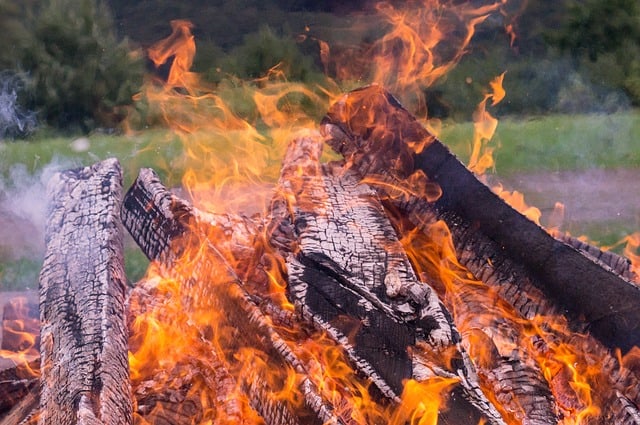The campfire is an essential part of any campsite. For most of us, it’s one of the first things on our to-do list when camping. Setting up and maintaining a campfire though can be challenging. That’s why we created this list of campfire hacks and tips to help make the campfire less work and easier to manage.
Starter Campfire Hacks
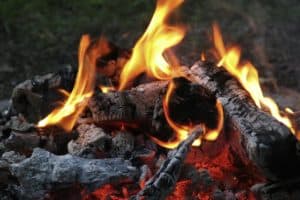 Campfire Hacks and Building Blocks – Before starting a campfire have all three types of basic campfire materials ready and plentiful including tinder, kindling, and fuelwood. Tinder is used when first starting a campfire and tends to light and burn very quickly examples include dry leaves, dry grass, and wood shavings. Next comes kindling which takes a campfire from the first few flames to an established campfire. Small twigs and branches make great kindling. To maintain the campfire and to keep it burning finally switch to fuelwood. Fuelwood is typically more substantial wood and can be anything from logs to medium-size branches that are about the width of your wrist or forearm.
Campfire Hacks and Building Blocks – Before starting a campfire have all three types of basic campfire materials ready and plentiful including tinder, kindling, and fuelwood. Tinder is used when first starting a campfire and tends to light and burn very quickly examples include dry leaves, dry grass, and wood shavings. Next comes kindling which takes a campfire from the first few flames to an established campfire. Small twigs and branches make great kindling. To maintain the campfire and to keep it burning finally switch to fuelwood. Fuelwood is typically more substantial wood and can be anything from logs to medium-size branches that are about the width of your wrist or forearm.
Nice and Dry – When collecting firewood for your campfire make sure the wood is nice and dry. A good test for how dry the wood is by breaking it. If the wood snaps and breaks the wood should be plenty dry and great for the campfire. If however the wood bends and doesn’t break its to damp and wet for campfire use and it’s best to keep looking for a better source of dry tinder and kindling.
Use the Wind – When lighting your campfire know the direction of the wind and use it to your advantage. Face away from the wind when lighting the fire. This technique allows the wind to carry the flame through the tinder igniting it more quickly and evenly.
Bottoms Up – When lighting and starting a campfire always ignite the tinder at the lowest point possible. Flames will travel upwards so by lighting at the lowest point you will be sure to use all of the tinder when starting a fire.
Backup Tinder – A campfire is very fragile in the beginning and a gust of wind or loss of combustibles can quickly kill a fire. So when starting a campfire always make sure you have back up tinder close at hand to save a dying fire.
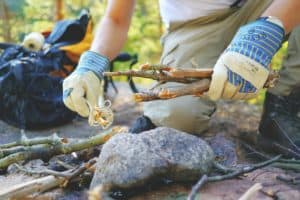 Split, Snap, and Break – Don’t use whole twigs and sticks for kindling when starting a fire. Instead split, snap, and break small twigs and sticks into smaller pieces. By doing this you will expose more of the inner dry wood and create more ignition points to keep the fire building faster and stronger.
Split, Snap, and Break – Don’t use whole twigs and sticks for kindling when starting a fire. Instead split, snap, and break small twigs and sticks into smaller pieces. By doing this you will expose more of the inner dry wood and create more ignition points to keep the fire building faster and stronger.
Airflow: the Lifeblood of a Campfire – Understanding and managing airflow is critical to the success of any campfire. A good campfire needs two main ingredients to burn, combustible material and oxygen. So when starting a campfire make sure to allow for good airflow over, around, and under your tinder and kindling.
Campfire Hacks and Having Options – Nature can be unpredictable and it’s always a good idea to have redundancy and backups when starting and lighting a campfire. Instead of just bringing a butane lighter to start a fire, bring several options in case one option gets lost, wet, or damaged. Packing a butane lighter, a waterproof case with matches, and a piece of flint will ensure that you can start a fire no matter what mother nature may throw your way.
Best Campfire Starter Materials (Not Provided by Nature)
Coghlan’s Waterproof Sticks – Even if you normally use natural materials found around the campfire for fire tinder. Having a few of these waterproof campfire starter sticks can make a great back up in case it rains. Check them out on Amazon here.
Toilet Paper Roll Fire Starters – An empty cardboard toilet paper roll stuffed with dryer lint can make a great DIY fire starter.
Chips and Cheese Puffs – While as a general rule we don’t recommend lighting your food sources on fire. In a pinch, you can actually use chips and cheese puffs as tinder to start a fire if no other viable option exists.
Egg Carton Fire Starters – A great DIY fire starter with a long burn time is the egg carton fire starter. To start with feel each empty egg slot with combustible material such as pine needles or sawdust. Then pour wax over the material filling up each egg slot. Once cooled cut out each egg partition to create handy and easy to light fire starters.
Cotton Ball Tinder – Cotton balls dipped in petroleum jelly will burn for several minutes each. They can be very messy though so a waterproof container of some sort is a must. Some great containers that can be used include ziplock baggies, empty pill bottles, or small Tupperware containers.
Steel Wool Fire – Another unique way to start a fire is to use steel wool as a tinder. When using this technique the finer the steel wool the better. Keep in mind that it will burn very fast so make sure to have some slower burning materials to catch the steel wool flame. As a bonus, if you don’t have a match or lighter available you can actually use a battery to ignite the steel wool.
Maintaining the Campfire Hacks
Thickness Matters – The general rule of thumb for burn times, is for every inch of thickness a log will burn for one hour. To keep the fire burning for a long duration the thicker the log the better. Keep in mind though you have to start small and work your way up in size when building a campfire. This technique also works in reverse. If you are planning on extinguishing the campfire soon, use smaller logs that will burn up faster. By doing this you will leave less of a mess and discarded half-burnt logs for the next camper.
Know Your Wood – There are two types of wood when it comes to maintaining a campfire, softwood, and hardwood. Softwoods like pines or firs will light easier but will burn down quickly. This makes softwoods great for the early stages of a campfire while you’re in the building stage. Hardwoods such as oak, maple, and ash will not light as quickly but have long burn times. Making hardwoods great for maintaining a fire without having to constantly add new wood. For a complete guide to different types of wood and trees check out this site.
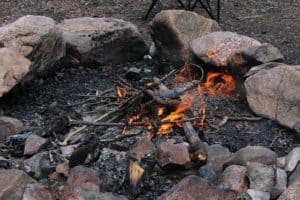 Campfire Hacks Stoking the Fire – Don’t forget a big part of keeping a campfire burning is not only adding fuelwood but also stoking the fire. To stoke, a fire make sure before you place new logs onto the campfire that the existing logs are well-positioned. When looking at log placement, proximity and airflow are the most important concerns. You want each log to be close enough to the next one to ensure each log is feeding off the flame and heat from the other. While airflow is critical when starting a fire it is also very important when maintaining one. Make sure log placement allows for proper airflow to each log to ensure a more stable and even burning fire.
Campfire Hacks Stoking the Fire – Don’t forget a big part of keeping a campfire burning is not only adding fuelwood but also stoking the fire. To stoke, a fire make sure before you place new logs onto the campfire that the existing logs are well-positioned. When looking at log placement, proximity and airflow are the most important concerns. You want each log to be close enough to the next one to ensure each log is feeding off the flame and heat from the other. While airflow is critical when starting a fire it is also very important when maintaining one. Make sure log placement allows for proper airflow to each log to ensure a more stable and even burning fire.
Keep an Eye on the Fire – Perhaps the best tip to maintaining a campfire is simply to keep an eye on it. Once you have built up a well-established campfire you don’t need to watch it every second. However, if you want to maintain a consistent even burning fire then you need to continue adding fuelwood and stoking the fire.
Extinguishing a Campfire Tips
Burn Up – If possible allow all wood to completely burn to ash before putting out the campfire. Doing this will allow the fire to be extinguished much easier and leaves less of a mess for the next camper.
Drown the Campfire – The fastest way to extinguish a campfire is with water. Pouring water directly onto the campfire drowning all embers until the hissing stops. Then with a camping shovel or a stick mix and turn up all the ash and embers and pour water onto the campfire again. Ensuring that all hot embers and ash have been completely extinguished and cooled.
Dirt and Sand – When camping you might not always have water or enough water to extinguish a campfire properly. In these situations, use dirt or sand to extinguish the fire. Using a shovel continually mix dirt or sand into the hot ash and embers. In essence, smothering and burying the campfire until cool.
Back of Your Hand – If the campfire isn’t cool then it’s not extinguished. Use the back of your hand to see if you feel any heat coming off the campfire. If you do then continue pouring water on or mixing dirt and sand into the campfire until cool. Do not directly touch the embers or ash as it could lead to a severe burn. Instead, see if you feel the heat radiating from the campfire by placing the back of your hand a few inches away from the ash and embers.
Cooking on a Campfire Hacks
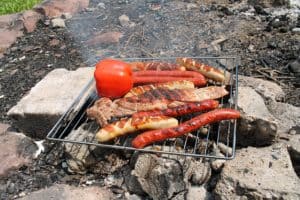 Bring Your Grate – To help make campfire cooking easier, bring along the grate from your home grill to use while cooking over a campfire using a few rocks on either side for a stand. This allows for much easier cooking on a flat surface and also will prevent food from tumbling into the fire.
Bring Your Grate – To help make campfire cooking easier, bring along the grate from your home grill to use while cooking over a campfire using a few rocks on either side for a stand. This allows for much easier cooking on a flat surface and also will prevent food from tumbling into the fire.
Prep at Home – The more prep work you do at home the easier campfire cooking will be. It’s much easier to cut, prep, and slice ingredients in a kitchen as opposed to a campsite.
Tin Foil is Your Best Friend – Tin foil can be used for all sorts of applications while campfire cooking. Tinfoil can be used as a cover over your grate to allow for easy cleanup. It can also be used to make a quick meal in a bag by simply placing all the ingredients into a tin foil pouch for cooking over the campfire.
Freeze-Dried Meals – If you don’t want to deal with the headache and hassle of refrigeration and ice while camping, consider freeze-dried products. All you need to do is add hot water to a freeze-dried meal and its ready to eat. While many may consider this not true campfire cooking, it can be a great simple alternative to more traditional campfire cooking. Mountain House makes some great tasting freeze-dried meals that you can check out here on Amazon.
Cast-Iron Cooking – When cooking over a campfire, there’s no better choice then cast-iron pots and pans. Cast-iron and campfire cooking go hand in hand because of its versatility, durability, and ease of use. In fact, a good cast iron pan might be all you need for cookware while camping. A versatile cast-iron pan will last forever and is just at home cooking morning breakfast as it is evening dinner.
Campfire Safety Tips
Give the Campfire a Wide Berth – When picking your campfire site make sure that there are no low hanging branches or brush nearby that could catch fire unintentionally. A good rule of thumb is to keep a radius of eight to ten feet around the campfire at all times that is clear of any camping gear or combustible material.
Making a Fire Pit – When building a campfire lay a good foundation for safety by building a suitable fire pit. To create a fire pit clear all debris away from the fire pit location such as grass or brush down to the soil. Then using medium size rocks build a circle around the intended campfire area, creating a barrier to prevent hot embers or sparks escaping the fire pit area. As an added bonus a good fire pit will also act as a nice wind block for your campfire.
Wheres the Water? – Always keep water near a campfire just in case something were to accidentally catch fire. It’s a good idea to keep at least a gallon near a campfire at all times just in case.
Never Leave Unattended – The number one rule to campfire safety is to never leave a campfire unattended even for a short period. Once a campfire is started until it is completely extinguished an adult needs to have an eye on the campfire at all times.
Campfires and Children – Make sure to educate young children that will be around the campfire about fire safety and the potential dangers of fire. It’s also a good idea to have an adult and not a child tend to the campfire including adding logs and stoking the fire for safety.
No Place for Flammable Liquids – NEVER use flammable liquids to start or build a campfire. Using flammable liquids to build a campfire puts your safety and others at extreme risk.
Extra Wood Storage – Stack extra wood upwind to avoid accidental ignition from flying embers or sparks.
Campfire Hacks Final Thoughts
We hope this list of campfire hacks and tips makes your next camping trip easier and more enjoyable while starting, maintaining, and extinguishing your campfire.
Do you have any campfire hacks or tips we might have missed? Comment below to let us know.

